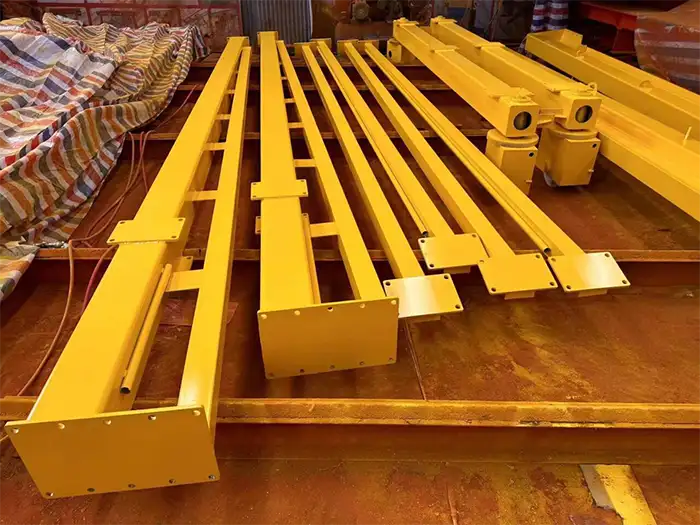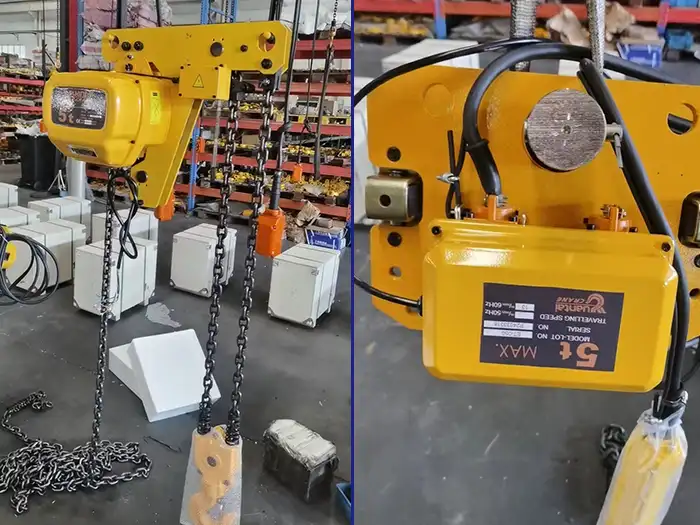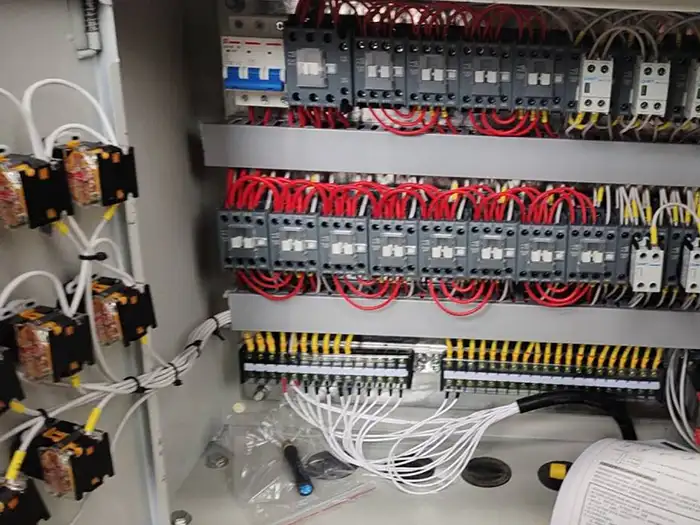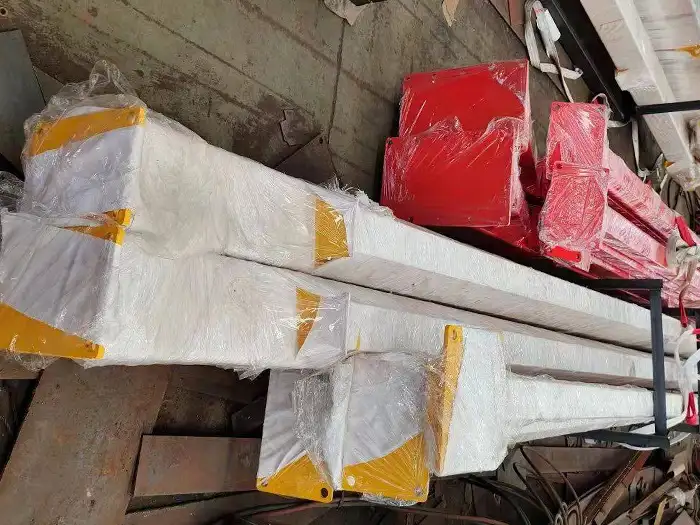5 Ton Portable Gantry Crane for Sale Trinidad and Tobago
5 Ton Portable Gantry Crane Non Rail Travelling with Electric Chain Hoist for Sale Trinidad and Tobago
Gantry cranes are crucial in various industrial settings, including construction sites, warehouses, and manufacturing plants. These cranes are designed to lift and move heavy loads efficiently, offering significant advantages over other types of cranes. They can span large areas and handle substantial weights, making them versatile tools for material handling.
Portable gantry cranes, a specific type of gantry crane, bring additional benefits. Unlike fixed gantry cranes, portable models are designed for mobility. They do not require rail tracks, allowing them to be easily moved and repositioned as needed. This feature is particularly advantageous in dynamic work environments where flexibility and space optimization are essential. Portable gantry cranes are also easier to set up and dismantle, which is ideal for projects requiring temporary or adaptable lifting solutions.
This case study focuses on a 5 ton non-rail travelling portable gantry crane equipped with an electric chain hoist. The aim is to provide an in-depth analysis of this crane's specifications and performance capabilities. We will examine how its features—such as its lifting capacity, span, and height—meet the demands of various industrial tasks.
Additionally, the case study evaluates the crane's suitability for use in Trinidad and Tobago. This includes assessing how well the crane's specifications align with local industrial needs and environmental conditions. By doing so, we aim to provide valuable insights into its practical application and benefits for businesses operating in this region.
Crane Specifications of 5 Ton Portable Gantry Crane Cases for Your Reference
Crane Type
The 5 ton non-rail travelling portable gantry crane is a versatile and practical lifting solution designed for flexibility and ease of use. Unlike traditional gantry cranes that require fixed rail tracks for movement, this model is designed to operate without rails. This allows it to be easily repositioned across various locations within a worksite or between different sites.
The portability feature makes it an ideal choice for dynamic environments where space and layout can change frequently. It simplifies setup and relocation, reducing downtime and increasing efficiency. Without the need for permanent installation, this crane provides a cost-effective solution for temporary or adaptable lifting needs.
Crane Capacity
With a lifting capacity of 5 tons, this crane is well-suited for handling heavy loads in various industrial applications. This capacity allows it to lift and move substantial materials, such as large machinery, equipment, or heavy components, with ease. It is commonly used in manufacturing plants, construction sites, and warehouses where the movement of heavy items is frequent and necessary.
The 5 ton capacity strikes a balance between power and manageability, making it versatile enough to tackle a wide range of lifting tasks while remaining easy to operate and control.
Crane Span
The crane features a span of 4 meters. The span refers to the distance between the two vertical supports of the gantry crane. A 4-meter span is suitable for handling a variety of loads within a moderate workspace, providing ample clearance and reach for lifting and maneuvering items.
The span size directly affects the crane's ability to cover a specific work area. A well-chosen span ensures that the crane can efficiently reach and handle loads across the desired range, improving productivity and operational flexibility.
Crane Lifting Height
The crane offers a lifting height of 6.5 meters. This height represents the maximum vertical distance the crane can lift objects from its base. A lifting height of 6.5 meters enhances the crane’s ability to access higher storage levels or lift items to elevated positions.
Increased lifting height improves operational flexibility, allowing the crane to handle tasks that require reaching higher points, such as loading and unloading materials from elevated platforms or positioning equipment at various heights.
Power Supply
The crane operates on a power supply of 440V, 60Hz, 3-phase. This power specification is essential for ensuring the crane's electrical systems function efficiently and reliably.
Compatibility with local power systems in Trinidad and Tobago is crucial. The specified power requirements match the typical electrical standards in the region, ensuring that the crane can be integrated into existing infrastructure without requiring additional modifications. This compatibility contributes to smooth installation and operational reliability. Main steel structure of 5 ton portable gantry crane for sale
Main steel structure of 5 ton portable gantry crane for sale  low headroom electric chain hoist
low headroom electric chain hoist
 electrical box
electrical box
 Packed
Packed
Project Location
Industrial Landscape in Trinidad and Tobago
Trinidad and Tobago's industrial landscape is diverse, with key sectors including manufacturing, construction, energy, and logistics. Each sector presents unique demands for material handling equipment like gantry cranes.
- Manufacturing: In this sector, gantry cranes are essential for moving heavy components, machinery, and raw materials. They facilitate the assembly, loading, and unloading processes, improving operational efficiency.
- Construction: Gantry cranes are widely used on construction sites for lifting and positioning heavy building materials, such as steel beams, concrete panels, and machinery. Their portability and flexibility make them valuable for handling various loads and adapting to changing site layouts.
- Energy: The energy sector, including oil and gas, often requires heavy lifting equipment for maintenance and installation tasks. Gantry cranes help with the handling of large equipment and components, such as pumps and generators.
- Logistics: Warehousing and distribution centers use gantry cranes for organizing and moving goods. Their ability to handle heavy loads efficiently supports smooth logistics operations and storage management.
Specific Requirements or Considerations: In Trinidad and Tobago, gantry cranes must be adaptable to various operational environments and meet local safety and operational standards. They should be able to handle the specific types of loads typical in these sectors and operate efficiently under local conditions.
Site Conditions
Local Environmental Conditions: Trinidad and Tobago has a tropical climate with high humidity and occasional heavy rainfall. These conditions can affect crane operation and maintenance.
- Humidity and Corrosion: The high humidity levels can lead to increased risk of corrosion on crane components. Using materials and finishes that resist corrosion is essential for extending the crane’s lifespan and maintaining reliability.
- Rainfall and Wet Conditions: Regular exposure to rain can impact the crane’s electrical and mechanical systems. Proper weatherproofing and routine maintenance are necessary to ensure optimal performance and prevent damage.
Considerations for Crane Setup and Use:
- Foundation and Stability: The crane’s base must be stable and level to ensure safe operation. Given the tropical climate, it’s important to consider factors such as soil stability and potential for erosion.
- Weatherproofing: Equipment should be designed or adapted to withstand local weather conditions, including rain and high humidity. Protective covers and rust-resistant materials can help mitigate environmental impacts.
- Maintenance and Service: Regular maintenance is crucial in ensuring the crane remains in good working condition despite the challenging environmental conditions. Scheduled inspections and prompt repairs will help maintain the crane’s functionality and safety.
Overall, understanding these local conditions and requirements will help in effectively deploying and utilizing the 5 ton portable gantry crane in Trinidad and Tobago, ensuring it meets the operational needs of various industrial applications.
Case Study Application
Project Overview
For this case study, let’s consider a hypothetical project at a construction site in Trinidad and Tobago. The project involves the installation of large structural components, including steel beams and concrete panels, for a new warehouse building.
The 5 ton portable gantry crane is employed to handle these heavy materials. Its primary tasks include:
- Loading and Unloading: The crane is used to lift and move steel beams and concrete panels from delivery trucks to designated areas on the site.
- Positioning: It positions these components precisely where they are needed for assembly, reducing manual handling and improving accuracy.
- Material Handling: The crane helps in rearranging materials and equipment within the construction site, adapting to changes in workflow and site layout.
The operational needs addressed by the crane include its flexibility in moving across different parts of the site, its ability to handle heavy loads efficiently, and its suitability for various lifting tasks required during the construction process.
Benefits of the Crane for the Project
- Efficiency Improvements: The portable design of the gantry crane allows for quick setup and relocation, which minimizes downtime and accelerates the construction schedule. The crane’s lifting capacity ensures that heavy materials are moved swiftly and safely, increasing overall productivity.
- Cost-Effectiveness: By reducing the need for additional lifting equipment and manual labor, the crane helps cut operational costs. Its portability means it can be used for multiple tasks across the site, offering significant savings compared to fixed or larger cranes that might require more extensive setup and operational costs.
- Operational Advantages: The crane’s non-rail travelling feature allows it to move freely within the site without the constraints of rail tracks. This flexibility is particularly valuable in dynamic environments where the layout may frequently change. The 5 ton capacity is well-suited for handling the types of materials used in the project, ensuring reliable performance throughout the construction phase.
Challenges and Solutions
Challenge: Environmental Conditions: The tropical climate of Trinidad and Tobago presents challenges such as high humidity and frequent rainfall, which can impact the crane’s components and operational efficiency.Solution: To address these issues, the crane is equipped with weatherproofing measures, such as corrosion-resistant coatings and protective covers for sensitive components. Regular maintenance schedules are established to inspect and address any wear or damage caused by environmental factors.
Challenge: Site Conditions: The construction site may have uneven terrain or unstable ground, affecting the crane’s stability and safety during operation.
Solution: Proper site preparation is crucial. The crane’s base is stabilized with appropriate leveling and support measures to ensure a safe working environment. Additionally, training for operators on handling the crane in varied site conditions helps prevent accidents and ensures proper use.
Challenge: Integration with Local Infrastructure: The crane’s power supply specifications must align with the local electrical infrastructure to avoid compatibility issues.
Solution: The crane is designed to match the local power supply standards (440V, 60Hz, 3-phase). Coordination with local electrical experts ensures that the crane’s power requirements are met and that installation is carried out smoothly.
By addressing these challenges with tailored solutions, the 5 ton portable gantry crane demonstrates its suitability and effectiveness for the project in Trinidad and Tobago, highlighting its adaptability and reliability in diverse conditions.
Conclusion
The 5 ton portable gantry crane has proven to be a valuable asset for the hypothetical construction project in Trinidad and Tobago. Its specifications, including a 5 ton capacity, 4-meter span, and 6.5-meter lifting height, have significantly contributed to the project's efficiency and effectiveness. The crane's non-rail travelling design allows for flexibility and easy repositioning across the site, while its 440V, 60Hz, 3-phase power supply ensures compatibility with local electrical standards.
The benefits of the crane include enhanced operational efficiency through quick setup and versatile use, cost-effectiveness by reducing the need for additional equipment and manual labor, and overall improvements in handling heavy materials. The crane's design has supported the successful completion of various tasks, such as loading, unloading, and positioning, aligning well with the project's requirements.
Future Considerations
For similar projects or other applications in Trinidad and Tobago, several considerations can enhance crane performance and project outcomes:
- Recommendations for Similar Projects: Future projects should consider the crane’s adaptability to different site conditions and environmental factors. Investing in portable gantry cranes with similar specifications can provide flexibility and efficiency for diverse material handling needs. Regular maintenance and weatherproofing will ensure long-term reliability.
- Additional Equipment Needs: Depending on the specific requirements of future projects, additional equipment, such as lifting accessories or extended reach options, might be necessary. Assessing these needs early can help in planning and optimizing crane use.
- Potential for Expanding Use or Upgrading Features: The potential for expanding the crane's use or upgrading its features should be evaluated. Options could include adding advanced control systems, increasing lifting capacity, or incorporating automation features for enhanced productivity. Upgrading the crane’s components or introducing additional features can further improve its performance and adaptability to various industrial applications.
Overall, the 5 ton portable gantry crane has demonstrated its effectiveness and suitability for the project, providing valuable insights into its benefits and potential areas for future enhancement.




